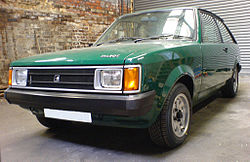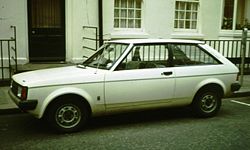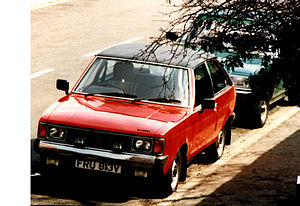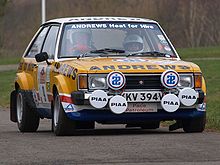- Chrysler Sunbeam
-
For the Sunbeam-Talbot or Sunbeam-Talbot-Darracq cars, see Sunbeam.
Chrysler Sunbeam 
Manufacturer Chrysler Europe
PSAAlso called Talbot Sunbeam (1980-1981) Production 1977-1981 Predecessor Hillman Imp Successor Talbot Samba Class Supermini Body style 3-door hatchback Layout FR layout Engine 928 cc ohc I4
1295 cc ohv I4
1598 cc ohv I4
2172 cc 16V Lotus slant 4Transmission 4 speed manual[1] Wheelbase 2,413 mm (95.0 in)[1] Length 3,829 mm (150.7 in)[1] Width 1,603 mm (63.1 in)[1] Height 1,395 mm (54.9 in)[1] Curb weight 1,260 kg (2,800 lb) - 1,320 kg (2,900 lb)[1] Related Hillman Avenger The Chrysler Sunbeam is a small supermini 3-door hatchback manufactured by Chrysler Europe at the former Rootes Group factory in Linwood in Scotland. The Sunbeam's development was funded by a British government grant with the aim to keep the Linwood plant running, and the small car was based on the larger Hillman Avenger also manufactured there. After the takeover of Chrysler's European operations by PSA, the model was renamed Talbot Sunbeam and continued in production until 1981.[2] A Talbot Sunbeam Lotus version was successful in rallying and won the World Rally Championship Manufacturers' title for Talbot in 1981.
Contents
Background
In mid-1970s, the British automotive industry was in crisis, marred by frequent strikes and decreasing competitiveness compared to the increasingly successful Japanese automakers. It took its toll on Chrysler UK, which was the name given to the former Rootes Group after its takeover by the USA-based Chrysler Corporation. In particular, the Linwood facility was generating losses due to many reasons, including underutilized capacity.[3]
In 1975, the famous Ryder Report led to the effective nationalization of Chrysler UK's major competitor, British Leyland. Chrysler management decided that the company should therefore also benefit from state aid, and pressed the government for it by threatening to close the UK operations. The government agreed to a state grant reported at GBP 55 Million[1] to fund the development of a small car, to be developed in Chrysler's UK facilities and manufactured in Linwood.[3]
Development
The development of the new car started in January 1976 under the codename Project R424. The technical side was the responsibility of the engineering team in Ryton, while the styling was the responsibility of Chrysler's Whitley design studio in Coventry, led by Roy Axe (who would leave the UK for Chrysler's headquarters in the USA before the car was launched). Many constraints, such as very tight schedule, low budget and the need to use as many British components as possible, led to the decision to use the rear-wheel drive Hillman Avenger as the base for the new vehicle, rather than the more trendy front-wheel drive constructions of Chrysler's French subsidiary, Simca. The Sunbeam was, unlike the larger Horizon and Alpine models which were launched by Chrysler in the mid to late 1970s, never sold in France as a Simca.[3]
Basing the car on the Avenger's platform allowed for the car not only to use as many already existing components as possible, but also to put it in production in Linwood quickly and at minimal investment. The Avenger's wheelbase was shortened by 3 inches (76 mm), and some modifications were made to accommodate the small 928 cc Coventry Climax engine, a version of the unit inherited from the little Hillman Imp also made in Linwood. Other than that, most components were identical to those of the Avenger.[3][4] Nevertheless, the little car took its steering wheel and instrument pod from Chrysler's recently launched award winning Simca 1307/Chrysler Alpine.[1]
On the outside, with the exception of the doors which were straight from the 2 door Avenger, the R424 was given an all-new body, styled very much in line with Chrysler's new, angular "international" style conceived by Roy Axe, which was first presented with the debut of the 1975 Simca 1307/Chrysler Alpine, and would later also be represented by the 1977 Simca/Chrysler Horizon (Project C2). This ensured the R424 would fit in well with the new Chrysler lineup and come across as fairly modern. Nevertheless, a constraint in the development process took its toll on the initial look of the car - as the C2's (Horizon's) headlamps would not be available at the planned launch time of the R424, the small car was given the lamps of the recently facelifted Avenger, which required the characteristic "recessed" mounting in the front fascia.[3] The GLS version had a vinyl roof as standard.
There was only one body style for the Sunbeam, that of a 3 door hatchback. The car was literally a hatchback, with the rear hatch formed out of a single piece of glass as seen previously on the Hillman Imp. That required a high rear sill to provide some structural rigidity and which consequently made the loading and unloading of luggage rather difficult. Although it was a good looking car with clean modern lines, the tricky luggage compartment and the lack of alternative bodystyles - a reasoning being that the Avenger range already offered saloon and estate variants - ultimately compromised the car's appeal in the UK market. The Sunbeam's main competitors in the UK, the Ford Escort, Vauxhall Chevette and Austin Allegro were produced in different body styles to cater for a broader range of customer.
On the interior side, the GL version is the first car ever to sport printed "melded" fabric from Cambrelle on its seats.[5] These have been considered similar to the Avenger in their comfort.[6]
The story of the car's name is also interesting - until the R424 launch, most Chrysler UK products were marketed in export markets under the Sunbeam brand of the former Rootes portfolio. Chrysler, however, was striving to cut down on the Rootes brand palette (which at that time existed solely by means of badge engineering) and introduce a pan-European image using the Chrysler brand as the only one for the whole range. The result was naming the car "Chrysler Sunbeam", and the Sunbeam brand was discontinued, with the remaining Rootes Group models also rebranded as Chryslers in 1976.[3]
The launch
After a remarkably short development period of just 19 months, the Chrysler Sunbeam was launched on the July 23, 1977, to a quite positive reception of the British automotive press. A memorable advertising campaign featured Petula Clark singing "...put a Chrysler Sunbeam in your life." There were three trim level available - the base LS, better-equipped GL and the most expensive GLS. To reduce in-house competition, the more basic versions of the two-door Avengers were dropped at the same time in the UK market, and the Chrysler Horizon was only available in five-door form. The Sunbeam sold well, but was not a runaway success.[3]
Even in spite of the ability to keep the UK business afloat, Chrysler was still making losses both in Europe and at home, and facing the possibility of complete bankruptcy, decided to sell Chrysler Europe to the French PSA. The French company took control of the former Chrysler Europe effective January 1, 1979, and in the course of the year announced all former Chrysler Europe products would be rebranded to Talbots starting August 1, 1979. Interestingly, the Sunbeam was simply rebadged in the strictest sense of the word, with the Chrysler badge on the bonnet replaced by one that read "Talbot", but retaining its grille with a prominent Chrysler pentastar until 1981.[3]
Sunbeam Ti and Sunbeam Lotus
In order to boost Sunbeam's image, a "hot hatch" version of the Sunbeam was launched at the 1978 British International Motor Show and Paris Motor Show, called Sunbeam Ti.[7] It was based on the former Avenger Tiger (itself hailing back to the Sunbeam Tiger), a sporty version of the Avenger. The 1.6-litre (1598cc) engine fitted to the Sunbeam with twin Weber carburetors delivered 100 bhp (75 kW; 101 PS). It featured sporty two-tone paint and body kit, and was very sport-oriented, being stripped of equipment that would compromise its performance (and image). It proved quite popular with reviewers and enthusiasts, and helped to emphasize the advantages of Sunbeam's rear-wheel drive against more trendy (and spacious) front-wheel drive rivals.[3]
Chrysler had also commissioned the sports car manufacturer and engineering company Lotus to develop a strict rally version of the Sunbeam. The resulting Sunbeam Lotus was based on the Sunbeam 1.6 GLS, but fitted with stiffer suspension, larger anti-roll bar and tougher gearbox casings. The drivetrain comprised an enlarged 2172 cc version of Lotus 2-litre, 16V slant four engine (the Sunbeam version being type 911, similar to Lotus 912), along with a ZF gearbox, both mounted in the car at Ludham airfield close to the Lotus facility in Hethel, Norfolk, where the almost-complete cars were shipped from Linwood. Final inspection, in turn, took place in Stoke, Coventry.[3]
The Sunbeam Lotus was unveiled at the Geneva Motor Show in April 1979, but the road-going version of the rally car was not actually ready for deliveries to the public until after the rebranding, and thus became the Talbot Sunbeam Lotus. At first these were produced mostly in black and silver, although later models came in a turquoise and silver (or black) scheme. The car saw not only enthusiastic press reviews, but also much success in the World Rally Championship - in 1980, Henri Toivonen won the 29th Lombard RAC Rally in one, and in 1981 the Sunbeam Lotus brought the entire Manufacturer Championship to Talbot.[3]
Sunbeam's short life
After the takeover, PSA decided that keeping Linwood running would remain unprofitable in the long run and that the facility would have to be closed. This would also mean the end of the Avenger and Sunbeam model lines. The decision was quite reasonable, given the advanced age of the former and the fact that the latter was little more than a stopgap model before a front-wheel drive three-door shorter version of the Horizon, called C2-short while in development, would be launched. Even though the C2-short programme was eventually scrapped, PSA prepared their own version, the Talbot Samba (based on PSA's own front-wheel drive supermini, the Peugeot 104), which was to be launched in 1981, signalling the time Sunbeam would take its final bow.[3][8]
Even though the end was looming, the Sunbeam was afforded a facelift for its final 1981 model year, finally gaining the flush headlamps along with an entire new front end, featuring the Talbot logo in lieu of the pentastar, which made it look completely in line with the new Talbot lineup. Until the time production ended, about 200,000 Sunbeams were made.[3]
References
- ^ a b c d e f g h "Fahrbericht: Chrysler Sunbeam: Schottosches Muster. In Schottland produzierter Kompaktwagen der Chrysler-Werke". Auto Motor u. Sport. Heft 19 1977: Seite 152–157. date 14 September 1977.
- ^ Graham Robson, A-Z of Cars of the 1970s, 1990, page 38
- ^ a b c d e f g h i j k l m "Development of the Chrysler Sunbeam cars". Rootes-Chrysler.co.uk – Rootes Group, Chrysler Europe, SIMCA, and Talbot cars. http://www.rootes-chrysler.co.uk/car-development/dev-sunbeam.html. Retrieved 2006-09-18.
- ^ "Development of the Hillman Imp cars". Rootes-Chrysler.co.uk – Rootes Group, Chrysler Europe, SIMCA, and Talbot cars. http://www.rootes-chrysler.co.uk/car-development/dev-imp.html. Retrieved 2006-09-18.
- ^ Society of Dyers and Colourists (1991). The International Dyer, Textile Printer, Bleacher and Finisher. Heywood & Co.., page 26.
- ^ Chrysler Sunbeam review at Carsurvey.org
- ^ Autocar 28 October 1978 p 35
- ^ "Development of the Talbot Samba cars". Rootes-Chrysler.co.uk – Rootes Group, Chrysler Europe, SIMCA, and Talbot cars. http://www.rootes-chrysler.co.uk/car-development/dev-samba.html. Retrieved 2006-09-18.
Categories:- 1970s automobiles
- 1980s automobiles
- Chrysler vehicles
- Hatchbacks
- Subcompact cars
- Rear wheel drive vehicles
- Vehicles introduced in 1977
Wikimedia Foundation. 2010.




